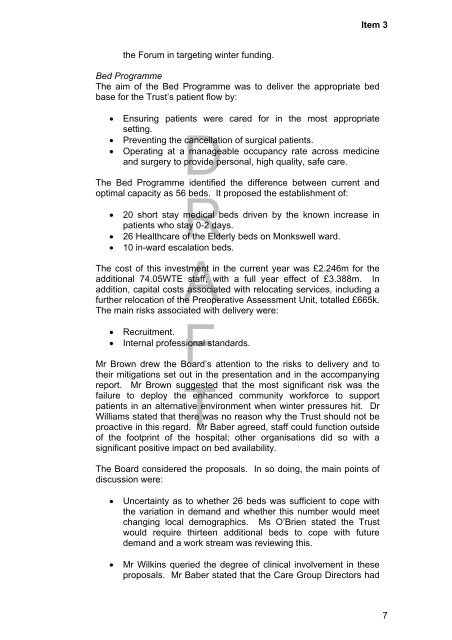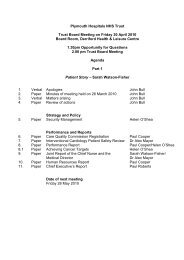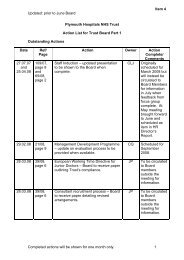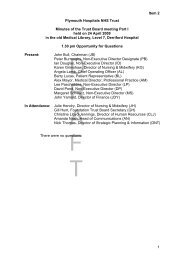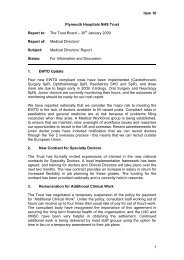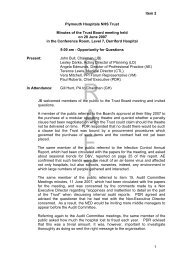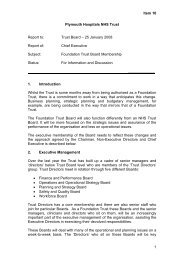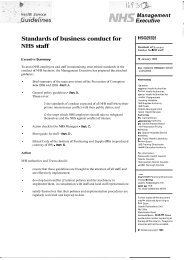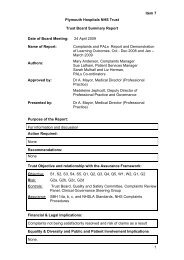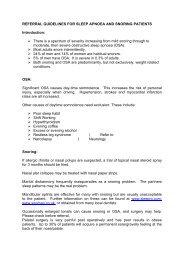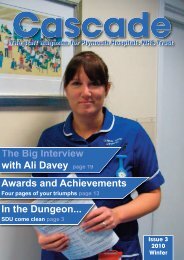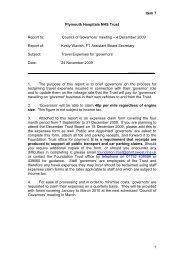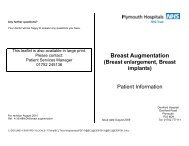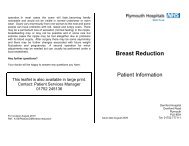Agenda and supporting papers - Plymouth Hospitals NHS Trust
Agenda and supporting papers - Plymouth Hospitals NHS Trust
Agenda and supporting papers - Plymouth Hospitals NHS Trust
Create successful ePaper yourself
Turn your PDF publications into a flip-book with our unique Google optimized e-Paper software.
Item 3<br />
the Forum in targeting winter funding.<br />
Bed Programme<br />
The aim of the Bed Programme was to deliver the appropriate bed<br />
base for the <strong>Trust</strong>’s patient flow by:<br />
• Ensuring patients were cared for in the most appropriate<br />
setting.<br />
• Preventing the<br />
D<br />
cancellation of surgical patients.<br />
• Operating at a manageable occupancy rate across medicine<br />
<strong>and</strong> surgery to provide personal, high quality, safe care.<br />
The Bed Programme identified the difference between current <strong>and</strong><br />
optimal capacity as 56 beds. It proposed the establishment of:<br />
R<br />
• 20 short stay medical beds driven by the known increase in<br />
patients who stay 0-2 days.<br />
• 26 Healthcare of the Elderly beds on Monkswell ward.<br />
• 10 in-ward escalation beds.<br />
A<br />
The cost of this investment in the current year was £2.246m for the<br />
additional 74.05WTE staff, with a full year effect of £3.388m. In<br />
addition, capital costs associated with relocating services, including a<br />
further relocation of the Preoperative Assessment Unit, totalled £665k.<br />
The main risks associated with delivery were:<br />
F<br />
• Recruitment.<br />
• Internal professional st<strong>and</strong>ards.<br />
Mr Brown drew the Board’s attention to the risks to delivery <strong>and</strong> to<br />
their mitigations set out in the presentation <strong>and</strong> in the accompanying<br />
report. Mr Brown suggested<br />
T<br />
that the most significant risk was the<br />
failure to deploy the enhanced community workforce to support<br />
patients in an alternative environment when winter pressures hit. Dr<br />
Williams stated that there was no reason why the <strong>Trust</strong> should not be<br />
proactive in this regard. Mr Baber agreed, staff could function outside<br />
of the footprint of the hospital; other organisations did so with a<br />
significant positive impact on bed availability.<br />
The Board considered the proposals. In so doing, the main points of<br />
discussion were:<br />
• Uncertainty as to whether 26 beds was sufficient to cope with<br />
the variation in dem<strong>and</strong> <strong>and</strong> whether this number would meet<br />
changing local demographics. Ms O’Brien stated the <strong>Trust</strong><br />
would require thirteen additional beds to cope with future<br />
dem<strong>and</strong> <strong>and</strong> a work stream was reviewing this.<br />
• Mr Wilkins queried the degree of clinical involvement in these<br />
proposals. Mr Baber stated that the Care Group Directors had<br />
7


